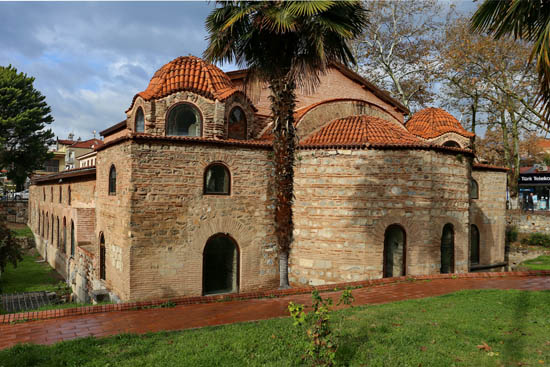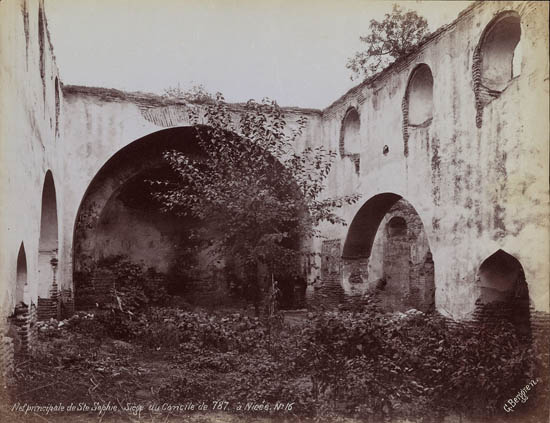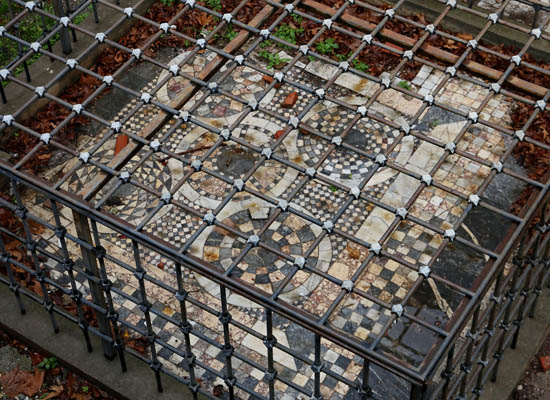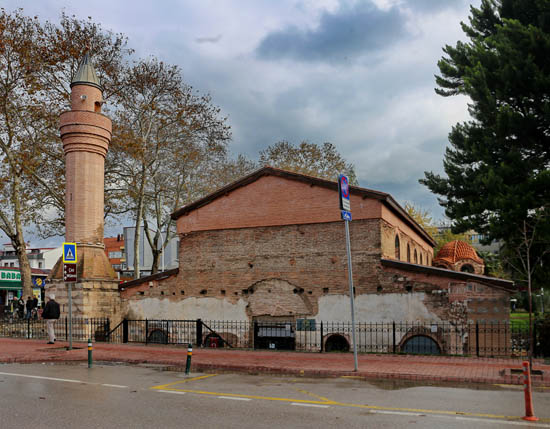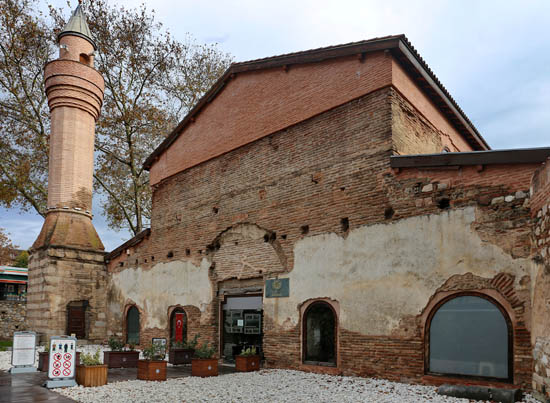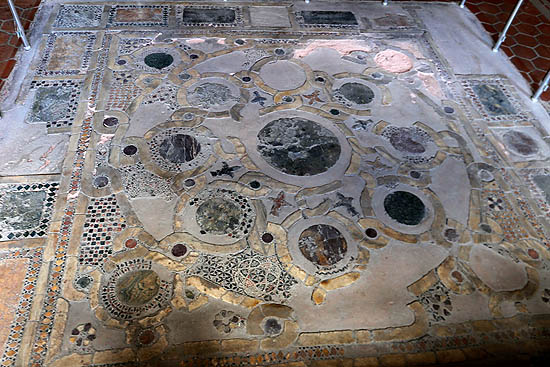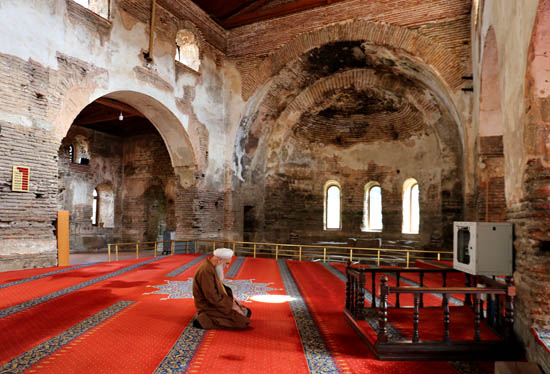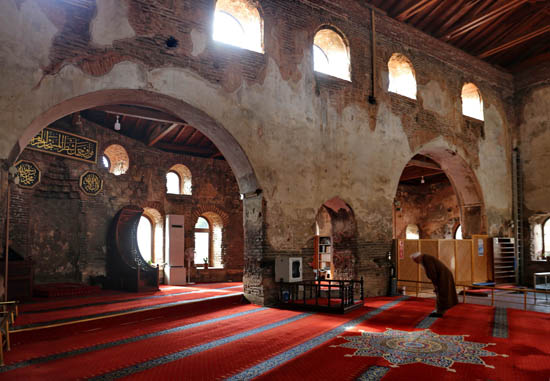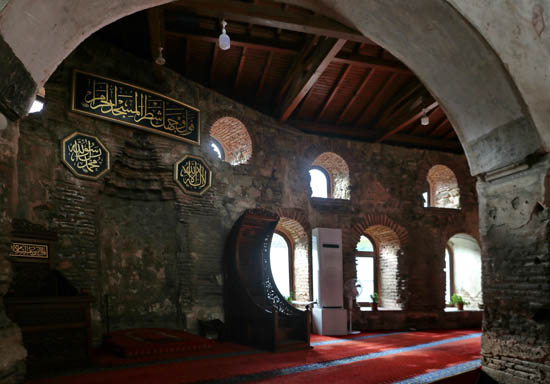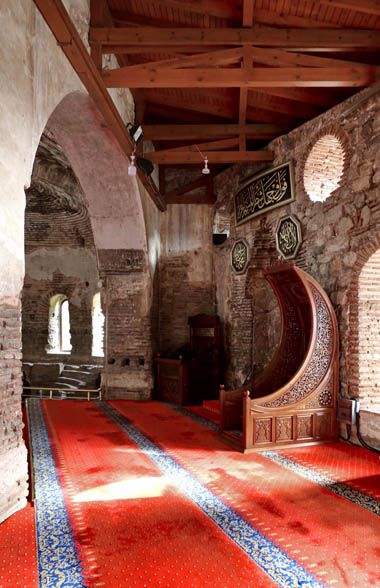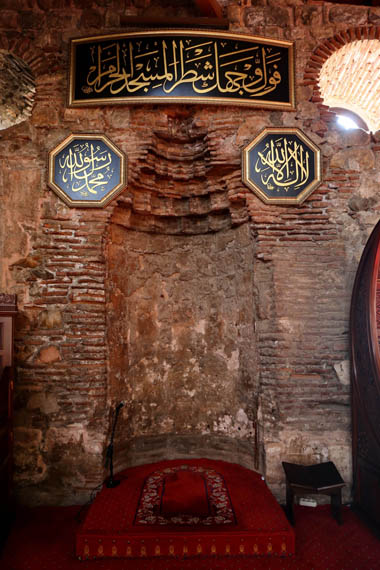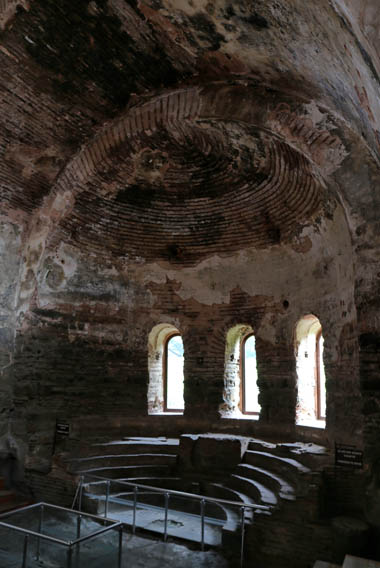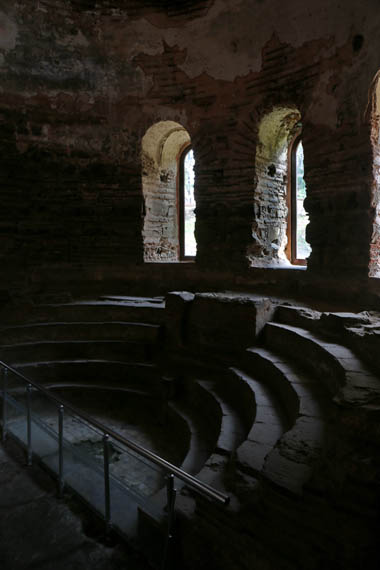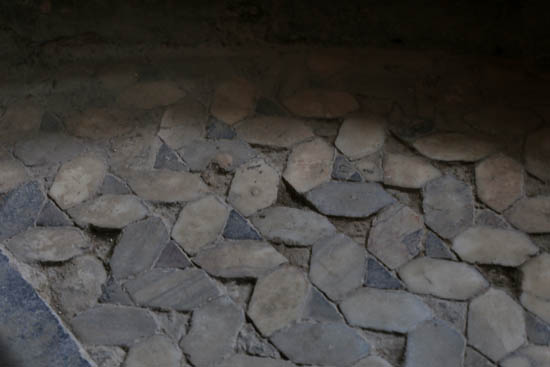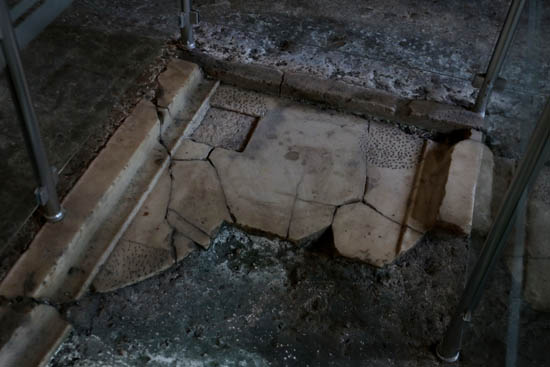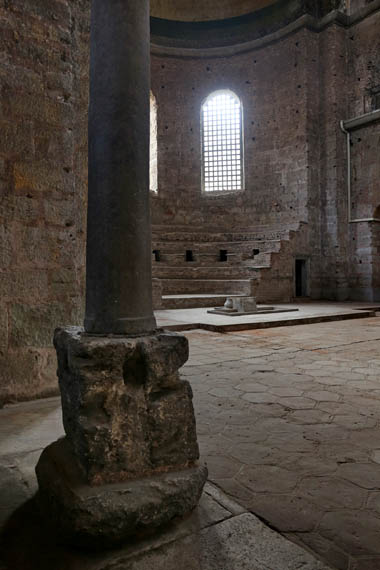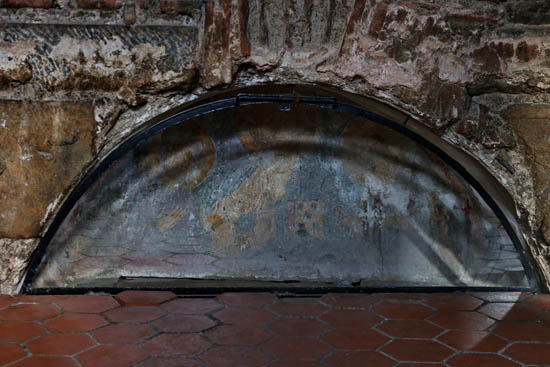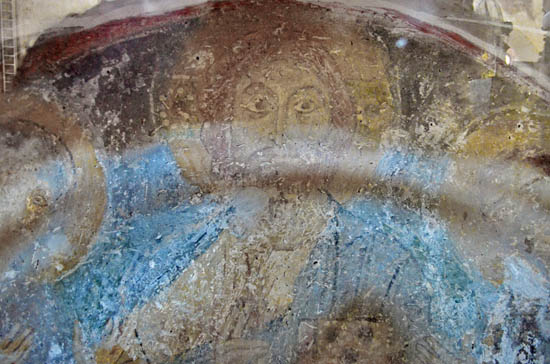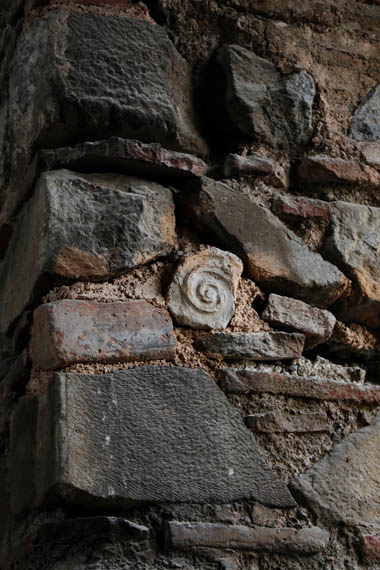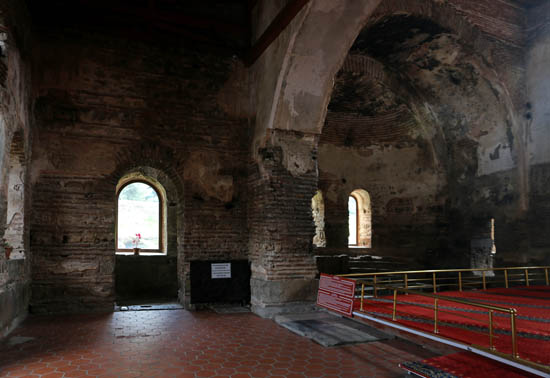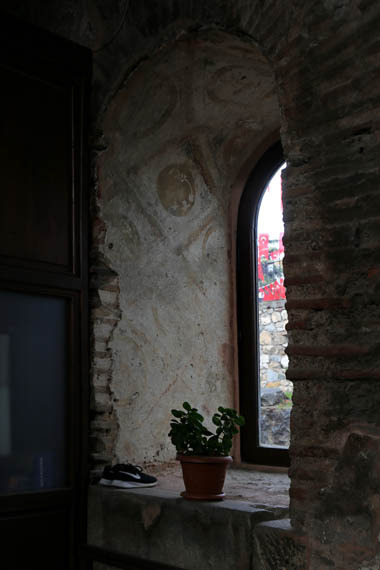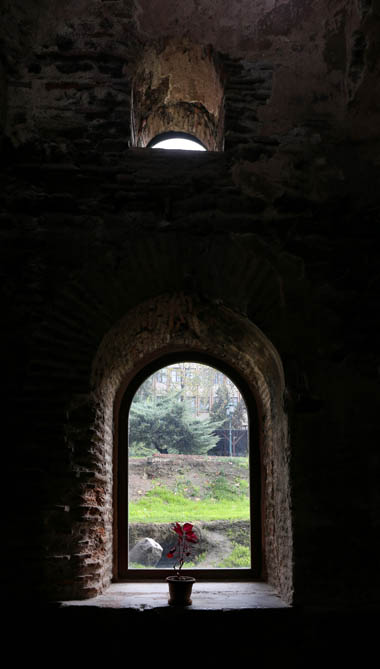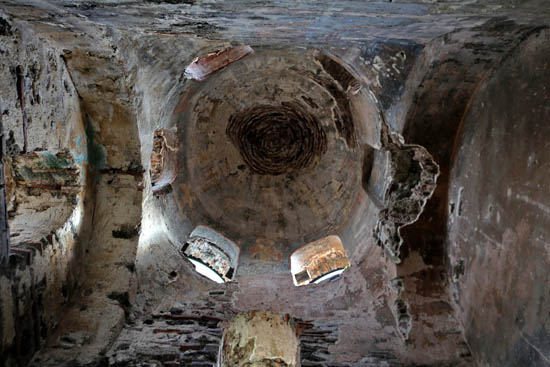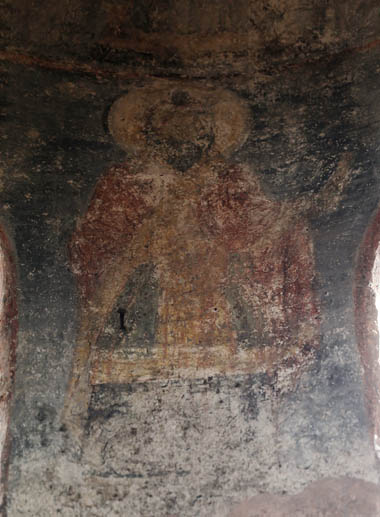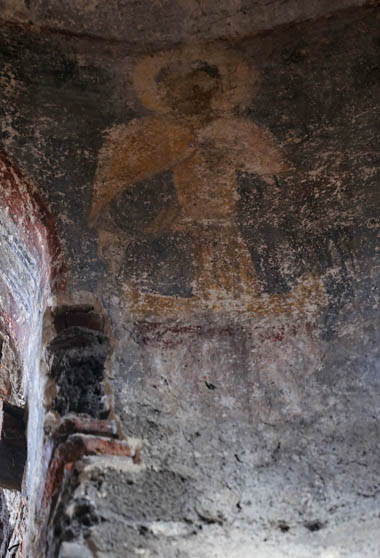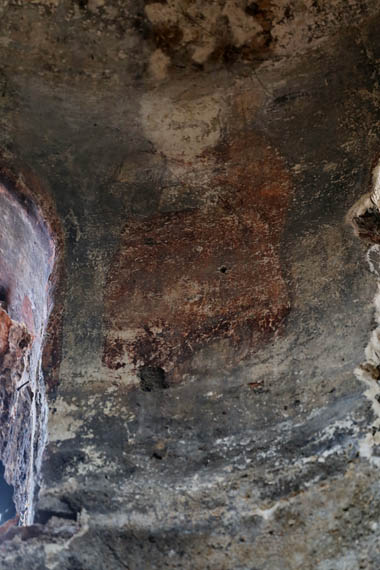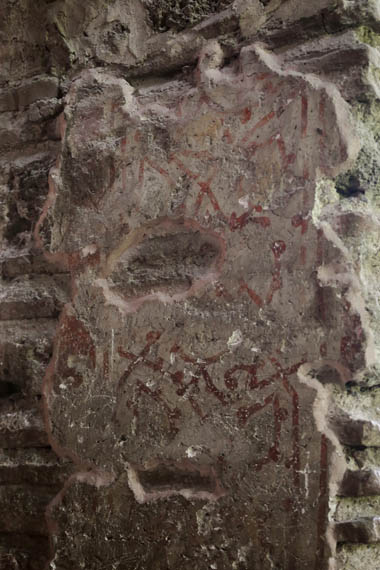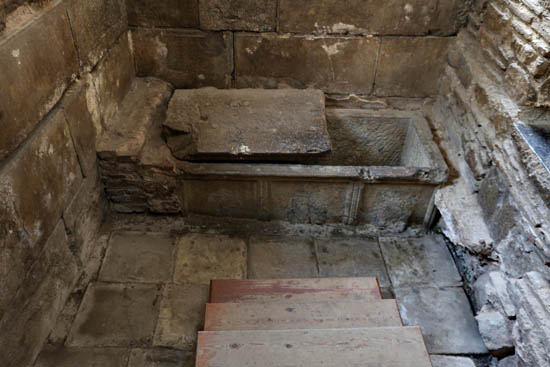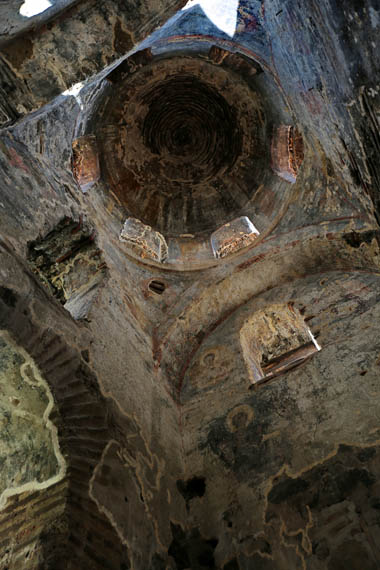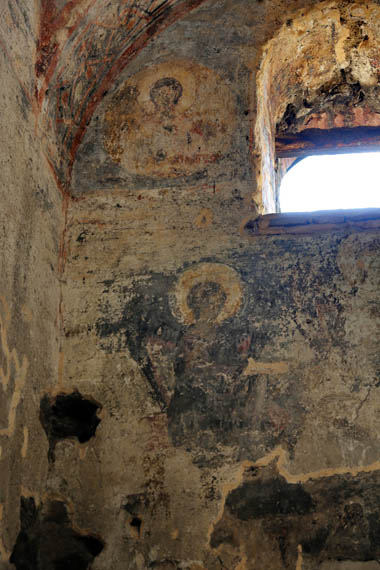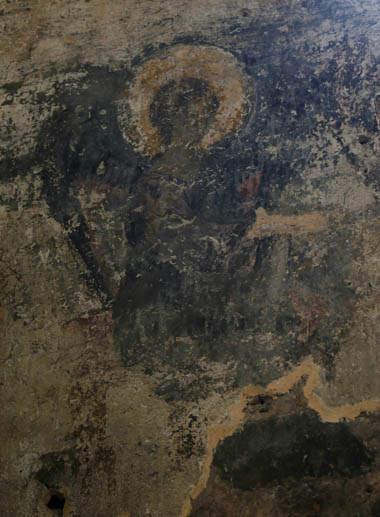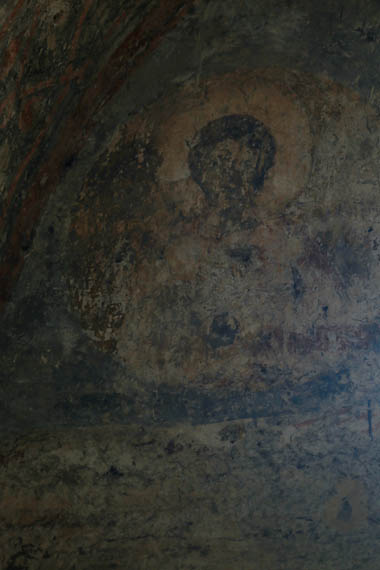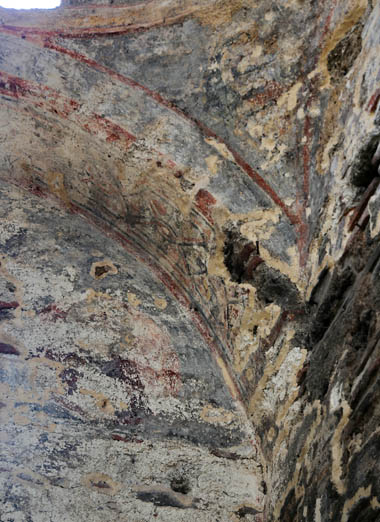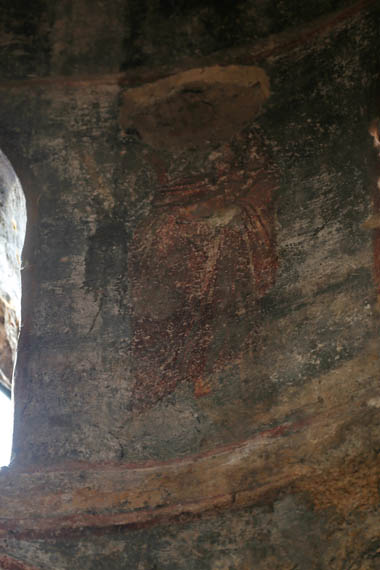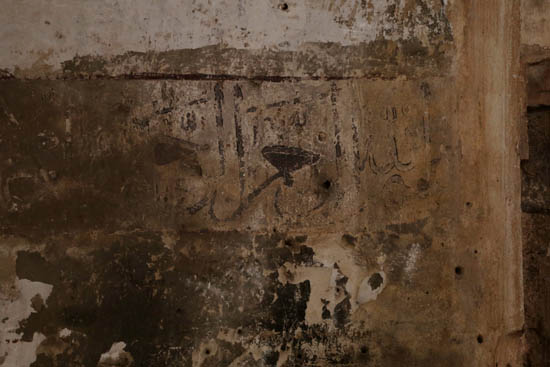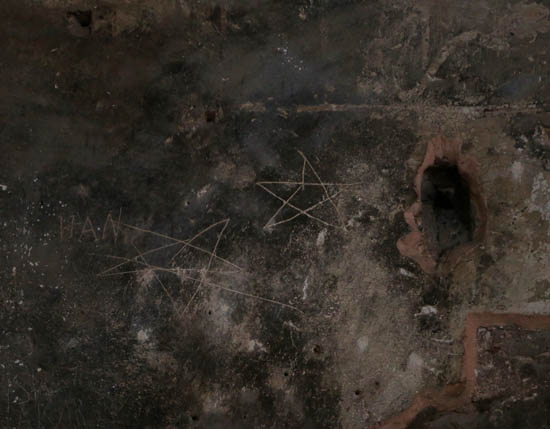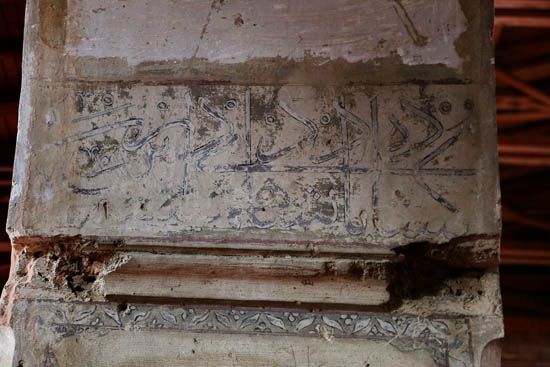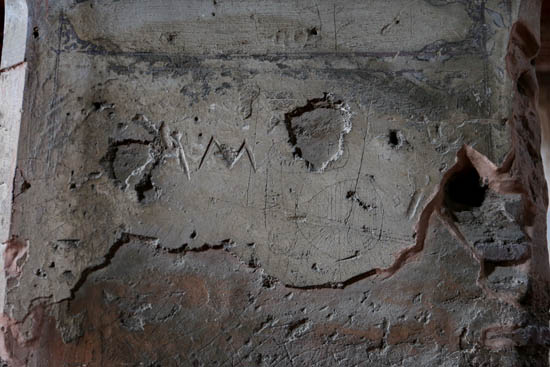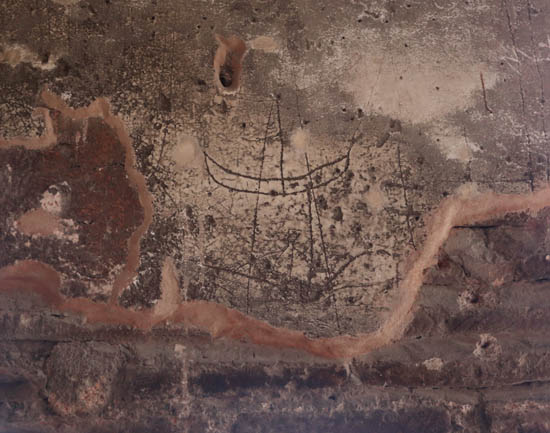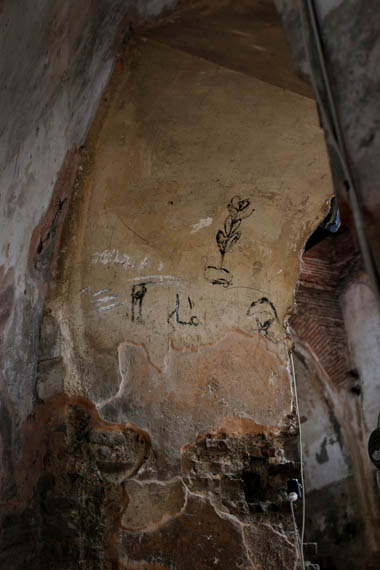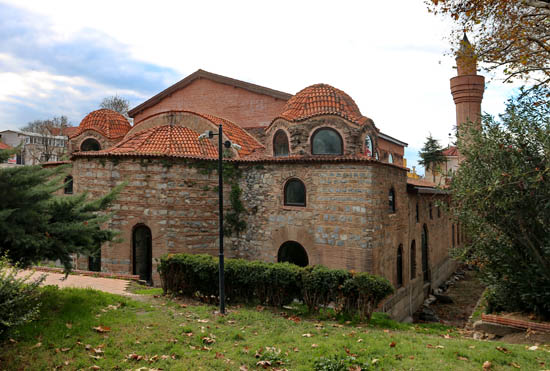Pronto nos despediremos de Blogger
y pasaremos a una nueva plataforma, donde
• en aún más idiomas
• con un material visual mucho más rico
• de forma más clara, mejor estructurada y más fácil de buscar
• y equipada con muchas herramientas nuevas
• publicaremos con más frecuencia y con contenidos aún mejores :)
Nuestra nueva página:
https://riowang.studiolum.com/es/
o en versión corta: https://riowang.com
Hasta que finalice el desarrollo completo de la nueva página
—aproximadamente a finales de año—
publicaremos nuestras entradas en ambas plataformas en paralelo,
pero a partir de Año Nuevo solo en la nueva.
Hasta entonces, vale la pena ir acostumbrándose, suscribirse al RSS,
probar con nosotros las nuevas funciones
y enviarnos sugerencias sobre qué y cómo deberíamos mejorar.
¡Gracias!
La iglesia principal de Nicea no es la misma que la enorme basílica que se hundió en el lago İznik, donde se celebró el Primer Concilio de Nicea en 325.
Aquella fue construida por Constantino el Grande a comienzos del siglo IV, fuera de las murallas de la ciudad, junto al lago y al llamado «Palacio del Senado», el centro local de la administración imperial, y dedicada al mártir local San Neófitos, que fue enterrado en el santuario de la iglesia. Probablemente se eligió para el concilio porque era lo suficientemente grande para acoger a 200 o 300 participantes.
La iglesia principal, sin embargo, se encontraba en el centro de la ciudad helenística, en la encrucijada de las dos calles principales. En tiempos del Primer Concilio ya debía haber una iglesia en este lugar, de la que no tenemos noticias. La primera versión del edificio actual fue encargada por el emperador Justiniano (527–565) y dedicada a Hagia Sophia, al igual que la iglesia principal de Constantinopla, también reconstruida por él.
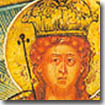 Hagia Sophia – Ἁγία Σοφία τοῦ Θεοῦ, Sabiduría Santa de Dios –, personificada en Proverbios 8–9 y Sabiduría 7–9 como חָכְמָה Chokmah, “Sabiduría” – se entiende en la tradición patrística y ortodoxa como el propio Cristo, como declara San Pablo: “Cristo es el poder de Dios y la sabiduría de Dios” (1 Cor 1:24). San Atanasio de Alejandría usó esta misma identificación en el Concilio de Nicea para argumentar contra los arrianos, señalando que Proverbios 8:22-32 presenta la Sabiduría – es decir, Cristo, según Pablo – como eterna. En esta tradición, Cristo, la Palabra hecha carne, también encarna la sabiduría del plan salvador de Dios, y por eso las iglesias de Hagia Sophia fueron consagradas a Cristo en reconocimiento de su papel divino como Salvador.
Hagia Sophia – Ἁγία Σοφία τοῦ Θεοῦ, Sabiduría Santa de Dios –, personificada en Proverbios 8–9 y Sabiduría 7–9 como חָכְמָה Chokmah, “Sabiduría” – se entiende en la tradición patrística y ortodoxa como el propio Cristo, como declara San Pablo: “Cristo es el poder de Dios y la sabiduría de Dios” (1 Cor 1:24). San Atanasio de Alejandría usó esta misma identificación en el Concilio de Nicea para argumentar contra los arrianos, señalando que Proverbios 8:22-32 presenta la Sabiduría – es decir, Cristo, según Pablo – como eterna. En esta tradición, Cristo, la Palabra hecha carne, también encarna la sabiduría del plan salvador de Dios, y por eso las iglesias de Hagia Sophia fueron consagradas a Cristo en reconocimiento de su papel divino como Salvador.
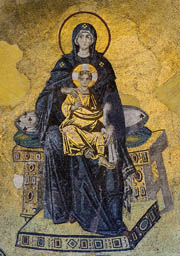 La liturgia y la iconografía ortodoxas representan la Sabiduría Divina, en muchas formas, como Cristo en el plan salvador de Dios. La iconografía católica es menos explícita; su fórmula más común es la estatua medieval de la Madonna, con el niño Jesús en su regazo, a menudo con la inscripción: “In gremio Matris sedet Sapientia Patris,” es decir, “La Sabiduría del Padre se sienta en el regazo de la Madre.” El santuario de Hagia Sophia en Constantinopla estaba decorado con un mosaico que reflejaba esta unión de tradiciones de Sabiduría oriental y occidental.
La liturgia y la iconografía ortodoxas representan la Sabiduría Divina, en muchas formas, como Cristo en el plan salvador de Dios. La iconografía católica es menos explícita; su fórmula más común es la estatua medieval de la Madonna, con el niño Jesús en su regazo, a menudo con la inscripción: “In gremio Matris sedet Sapientia Patris,” es decir, “La Sabiduría del Padre se sienta en el regazo de la Madre.” El santuario de Hagia Sophia en Constantinopla estaba decorado con un mosaico que reflejaba esta unión de tradiciones de Sabiduría oriental y occidental.
Curiosamente, en la iconografía popular rusa, Hagia Sophia se representaba sin tanta complejidad teológica como “Santa Sofía la Gran Mártir,” acompañada de sus tres hijas, Vera, Nadezhda y Lyubov – Fe, Esperanza y Amor –, quienes también cayeron víctimas de la opresión, como ha ocurrido con frecuencia en tierras rusas.
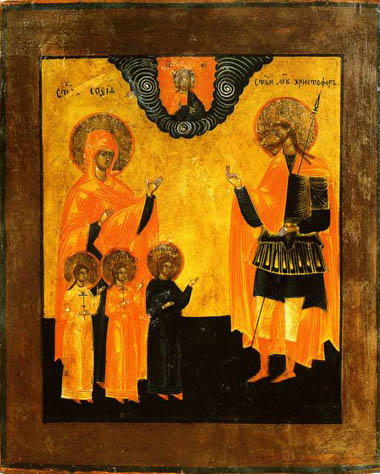 Intercambio de experiencias entre santos apócrifos. Santa Sofía y sus hijas en compañía del San Cristóbal de cabeza de perro, sobre quien ya escribimos. Siglo XIX, Moscú, Museo Estatal de Historia
Intercambio de experiencias entre santos apócrifos. Santa Sofía y sus hijas en compañía del San Cristóbal de cabeza de perro, sobre quien ya escribimos. Siglo XIX, Moscú, Museo Estatal de Historia
Esta iglesia también albergó un concilio ecuménico: el Segundo Concilio de Nicea, el séptimo y último concilio de la Iglesia Oriental y Occidental unidas en 787.
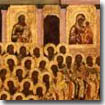 El concilio fue convocado por la emperatriz Irene, viuda de León IV y regente de su hijo, el emperador menor de edad Constantino VI, para resolver la controversia iconoclasta bizantina. Originalmente se reunió en Constantinopla en 786, pero los militares pro-iconoclastas bloquearon los procedimientos, así que se trasladó a Nicea.
El concilio fue convocado por la emperatriz Irene, viuda de León IV y regente de su hijo, el emperador menor de edad Constantino VI, para resolver la controversia iconoclasta bizantina. Originalmente se reunió en Constantinopla en 786, pero los militares pro-iconoclastas bloquearon los procedimientos, así que se trasladó a Nicea.
El decreto del concilio permitió la veneración de íconos, pero no su adoración, que se reserva solo a Dios. También declaró que el respeto mostrado a un icono se transmite a su sujeto, por lo que no puede considerarse idolatría – postura que más tarde repitió el Concilio de Trento (1545–63) frente a las acusaciones protestantes de idolatría. La justificación no se basó en argumentos cristológicos, como en el Concilio de Hieria de 754, sino en la antigüedad de la veneración de imágenes y la encarnación de Cristo, que hace posible su representación.
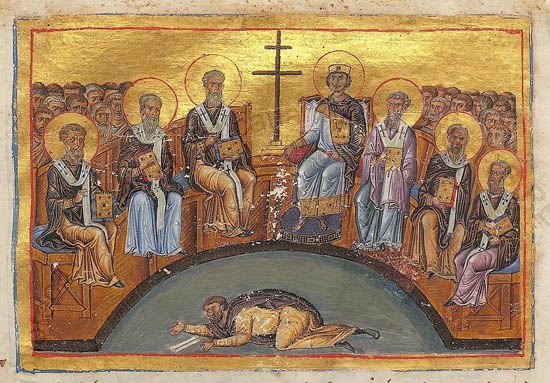 El Segundo Concilio de Nicea en el menologio de Basilio II (976–1025), Vat. Gr. 1613 fol. 108. Centro: Patriarca Tarasio y el emperador Constantino VI, en el suelo un iconoclasta humillado
El Segundo Concilio de Nicea en el menologio de Basilio II (976–1025), Vat. Gr. 1613 fol. 108. Centro: Patriarca Tarasio y el emperador Constantino VI, en el suelo un iconoclasta humillado
Lamentablemente, aquella iglesia del Concilio no ha sobrevivido. El edificio fue destruido en un terremoto en 1065, tras lo cual se construyó la estructura actual.
Los otomanos en expansión capturaron Nicea en 1331, y como era habitual, la iglesia principal se convirtió en mezquita, llamada Orhan Djami en honor al sultán conquistador. También construyeron una madraza y un baño, que no han sobrevivido.
La invasión de Tamerlán en 1402 dañó gravemente la mezquita, que sufrió un incendio a mediados del siglo XV y luego otro terremoto. Permaneció en ruinas durante un siglo, probablemente devastando los frescos bizantinos interiores.
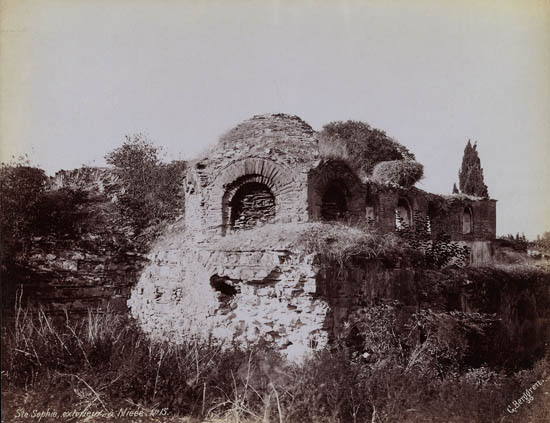 Fotos de Guillaume Berggren, c. 1870–80, mostrando el ábside noreste y el interior
Fotos de Guillaume Berggren, c. 1870–80, mostrando el ábside noreste y el interior
A principios del siglo XVI, los otomanos libraron una lucha de dos siglos contra la creciente dinastía persa safávida, principalmente a lo largo de la frontera otomano-persa habitada por armenios y kurdos. Ambos bandos a menudo deportaban comunidades enteras de afamados artesanos armenios para enriquecer sus propios territorios. En 1515, alfareros armenios de Tabriz fueron trasladados a İznik (como evolucionó el nombre de la ciudad del griego eis Nikaia, «a Nicea», de manera similar a Estambul de eis tan Polin, «a la Ciudad»). 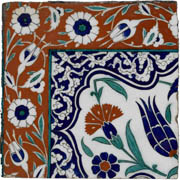 Aquí crearon los famosos azulejos de İznik usados en todo el imperio, incluida la Mezquita Azul de Estambul, cuyos motivos florales llegaron hasta las iglesias de Transilvania. La ciudad vivió una nueva edad de oro y los edificios arruinados fueron reconstruidos. La mezquita fue supuestamente restaurada por Sinan bajo el encargo del sultán Suleimán.
Aquí crearon los famosos azulejos de İznik usados en todo el imperio, incluida la Mezquita Azul de Estambul, cuyos motivos florales llegaron hasta las iglesias de Transilvania. La ciudad vivió una nueva edad de oro y los edificios arruinados fueron reconstruidos. La mezquita fue supuestamente restaurada por Sinan bajo el encargo del sultán Suleimán.
Durante la guerra greco-turca de 1920–22, la línea del frente se movió alrededor de Nicea. Las fuerzas griegas destruyeron pueblos turcos cercanos, y las tropas turcas entrantes expulsaron a la mayor parte de la población griega. Al final, el 60–70% del casco antiguo estaba en ruinas, todas las iglesias y monasterios colapsaron, y el arte cerámico de İznik quedó destruido. La población griega desplazada fue reemplazada por refugiados musulmanes balcánicos (muhacirs).
La dañada Hagia Sophia fue convertida en museo por Atatürk en 1935. Al igual que la Hagia Sophia de Estambul o la Iglesia de Chora, este gesto simbolizó el giro secular del país y una relectura de su pasado preislámico y de su múltiples capas.
Se realizaron investigaciones arqueológicas en 1935 y 1953, descubriendo pisos de mosaico bizantino y restos de frescos, y el nivel del suelo exterior se bajó dos metros y medio hasta los cimientos. También se reveló el piso de mosaico de la parekklesion sur (capilla exterior), que aún se muestra, expuesto a los elementos, bajo una reja de hierro protectora.
La restauración comenzó en 2007, incluyendo la reconstrucción del techo y la cúpula, así como del minarete. El trabajo se completó en 2011 y el edificio reabrió… como mezquita para el Kurban Bayramı, la Fiesta del Sacrificio de Abraham.
Este paso fue parte del proceso de re-islamización del país, anticipando la reconversión posterior de los museos-mezquitas de Estambul en mezquitas. La decisión provocó protestas a nivel nacional e internacional, e incluso algunos musulmanes locales se opusieron, argumentando que ya había suficientes mezquitas en la ciudad. Pero, contra todo ello, se llevó a cabo. Hoy, el edificio sigue funcionando como mezquita, aunque durante nuestra visita de una hora solo vimos a un único devoto, mientras que unos 20–30 turistas, en su mayoría locales, venían a visitar el monumento histórico.
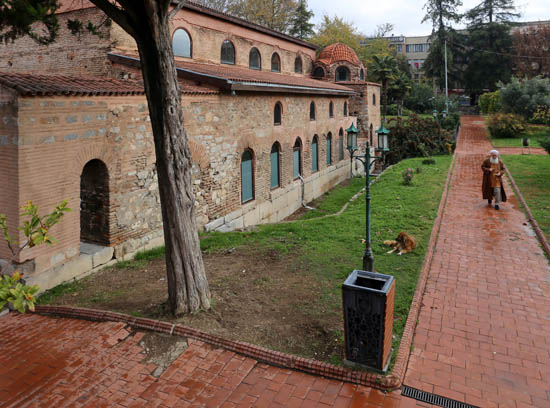 El único devoto llega – el propio imán – quien, rezando durante toda nuestra visita, se convierte en un personaje de fondo inevitable –pero con indudable estilo– en nuestras fotos, con su turbante blanco y su barba, su camisa amarilla y la túnica clerical marrón.
El único devoto llega – el propio imán – quien, rezando durante toda nuestra visita, se convierte en un personaje de fondo inevitable –pero con indudable estilo– en nuestras fotos, con su turbante blanco y su barba, su camisa amarilla y la túnica clerical marrón.
Al entrar en la mezquita, tres escalones bajan hasta el nivel del piso, donde se descubrió un hermoso mosaico bizantino justo frente a la entrada. Basándome en ejemplos cosmatescos italianos, lo dataría entre los siglos XII y XIII. Sin embargo, en la iglesia principal del Monasterio de Iviron en el Monte Athos, un mosaico de piso muy similar se retrotrae al siglo X.
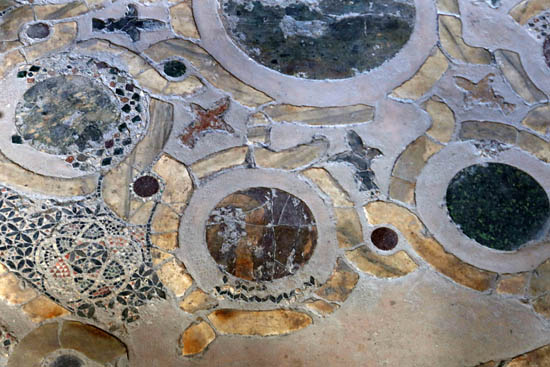 Una cosa es segura: los lirios que enmarcan de manera prominente la sección central del mosaico eran los símbolos de la familia Láscaris, que gobernó el Imperio de Nicea entre la ocupación de Constantinopla por Venecia en 1204 y la restauración de los Paleólogos en 1261.
Una cosa es segura: los lirios que enmarcan de manera prominente la sección central del mosaico eran los símbolos de la familia Láscaris, que gobernó el Imperio de Nicea entre la ocupación de Constantinopla por Venecia en 1204 y la restauración de los Paleólogos en 1261.
La iglesia es una basílica de tres naves, con una nave central muy espaciosa y naves laterales estrechas, un ábside central semicircular y ábsides laterales de extremos rectos, básicamente pequeñas habitaciones laterales cuadradas rematadas con diminutos domos del periodo tardío bizantino.
Durante la conversión en mezquita, se instalaron el mihrab, orientado hacia La Meca, y el minbar en la nave lateral sur.
El ábside del santuario principal está rodeado de estrados o tribunas escalonadas que servían de asiento al clero durante la liturgia, similar a la Hagia Irene de Constantinopla. El suelo está pavimentado con mosaicos de piedra, y al frente, en la ubicación del antiguo altar, hay una losa de mármol incrustada en el suelo.
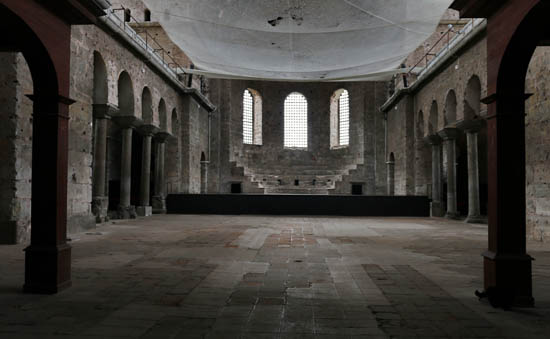 El santuario de Hagia Irene en Constantinopla con sus tribunas escalonadas. En la siguiente imagen, se puede ver que el altar allí también estaba sobre una losa de mármol empotrada.
El santuario de Hagia Irene en Constantinopla con sus tribunas escalonadas. En la siguiente imagen, se puede ver que el altar allí también estaba sobre una losa de mármol empotrada.
En la pared de la nave norte, probablemente en el tímpano de una antigua puerta, se descubrió en 1935 un fresco de Deesis que representa a la Virgen María y a Juan Bautista suplicando ante el Pantócrator de medio cuerpo. Es probable que esta puerta se tapiara temprano, lo que permitió que el fresco se conservara en buen estado.
Más cerca del santuario, permanece incrustada en los vanos de las ventanas la voluta de un antiguo capitel jónico de mármol.
Al final del pasillo norte se encuentra una habitación cuadrada, la prótesis, utilizada para preparar el pan y el vino litúrgico. Los elementos decorativos se han mantenido en los vanos de las ventanas, junto con los contornos de tres santos en el tambor. Varias pequeñas cruces incisas de la época de la iconoclasia, cuando estas eran las únicas decoraciones permitidas, aún son visibles en las paredes y bóvedas.
Al final del pasillo sur se encuentra otra habitación cuadrada, el diakonikon, utilizada como vestuario de los diáconos y para almacenar los ropajes litúrgicos. En el suelo, junto a la pared sur, hay un sarcófago de mármol. Sobre él, bajo la ventana, se ve un ángel de medio cuerpo a la izquierda. Arriba y a la izquierda y derecha de la ventana hay otros dos ángeles de medio cuerpo, el de la derecha apenas visible. El tambor presenta los contornos de dos santos. Estos debieron ser claramente visibles incluso cuando el edificio se convirtió en mezquita, ya que sus cabezas fueron evidentemente destruidas a martillazos.
De la fase anterior como mezquita del edificio, aún permanecen inscripciones árabes y grafitis en los arcos que conectan la nave con los pasillos y a la izquierda de la entrada.
En resumen, la iglesia una vez exhibió una decoración rica: frescos en las paredes y mosaicos de piedra en el suelo. La mayor parte de esto probablemente no se perdió durante la conversión a mezquita, sino a lo largo de los siglos en que permaneció sin techo y en ruinas. Es notable que tanto haya sobrevivido bajo la escasa protección de los arcos.
Igualmente notable es que sea esta iglesia bizantina la que haya sobrevivido más o menos en su forma original de entre las veinte que una vez existieron en Nicea, y de entre las muchos miles de todo el país. Exactamente esta, incluso convertida en mezquita, que acogió el Segundo Concilio de Nicea, y la otra, incluso bajo el agua, que acogió el Primero.
